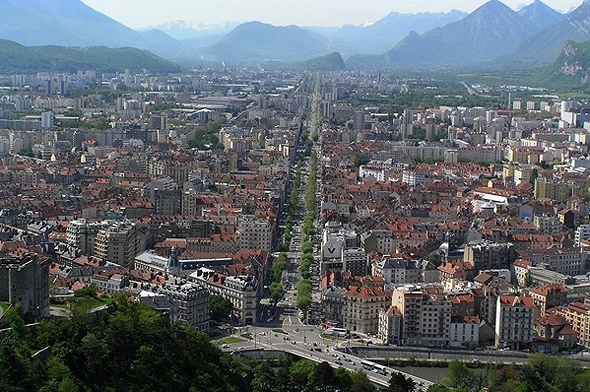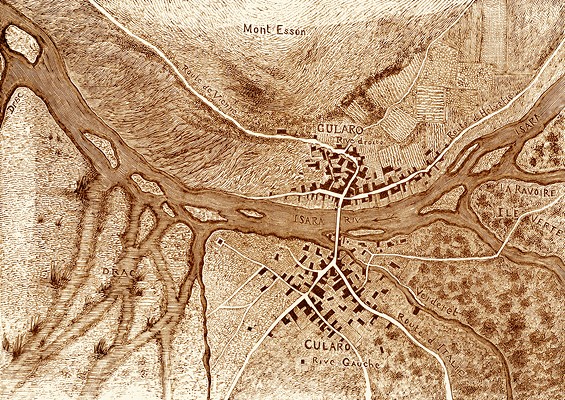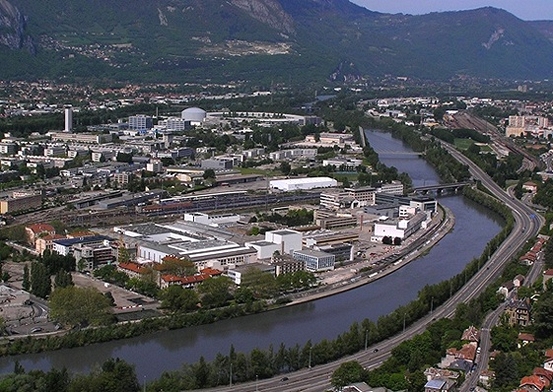Grenoble -around the Railway.
1. Introduction- Some history, rivers and railways.
-disused,
forgotten, taken away or
abandoned lines.
1. Introduction- Some history, rivers and railways.
All
the pictures can be enlarged with a mouse click!
Grenoble has certainly had its moments of glory and
action:
- in 218 BC by the passage of Hannibal with his army and elephants on his way through the Alps to battle with the Romans.
- Between 1675 and 1686, major work is undertaken to stabilize the capricious waters of the Drac, a furious mountain torrent on occasions. The 'Cours Saint Andre', built from 1684, results. The possibility of urbanization between the Drac and the old town becomes possible.
- On June 7, 1788 took place the famous "Day of the Tiles', during which the King's army is showered with tiles by the demonstrators on the roofs around the current Stendal High School. This event probably triggers the French Revolution.
- Napoleon, passing through the Alps on his return from the isle of Elba is received as a hero by the people of Grenoble on March 7, 1815. The route taken was known by the name 'Route Napoleon' or more recently the RN85.
- The arrival of the railway in Grenoble in 1858 marks a decisive step in the development of the city.
- The first Tourist Office was established in 1889 in Grenoble, testimony to the dynamism at that time.
- The electric tram network, the SGTE, is created in 1900 to serve the emerging built-up area in and around Grenoble.
- To promote Grenoble industry and tourism an international exhibition is held in 1925.
- The creation of the centre for Nuclear Studies in Grenoble in 1955 on the peninsula between the Drac and Isere.
- The organization of the Winter Olympic Games is entrusted to Grenoble in 1968.
- The opening of the modern electric tram network took place in Grenoble in 1987.
- Creation of the Europole in the place of the railway sorting station and a brewery in 1990.
- Creation of Minatec, centre for nanotechnology research on CENG nuclear-free land in 2002.
When Hannibal arrived in Grenoble, Cularo at that
time, he would have found a city very different from the one we know
today. The Isère flowed right up to mountain now called Mount Rachais
and the entrance to the city was by the road to Vienne, the Chalemont
steps. The Drac in turn, followed multiple paths between swampland.
The Verderet, a torrent which came from Eybens, cut across the city
center.

02- The 'cours Jean Jaurès' and its continuation, the 'cours de la Liberation' and the 'cours Saint André'.
Two recent photos of Grenoble taken from
the Bastille fort. On the left in the front, the Isere with it's
oblique bridge arriving at Hubert Dubedout square. The 'cours Jean
Jaures'(Liberation, Saint Andre) is the avenue which stretches from
here to 'Pont de Claix', nearly 8 km away. In the middle of the
picture, the avenue is crossed by the railway to Veynes and Chambery
on a viaduct, the Estacade. Before 1968, there was a level crossing
here. In the photo on the right, we can see the peninsula between the
Isere in the front and the Drac behind the CENG near the back. In the
middle of the photo, the railway crosses the Isere river on the Pique
Pierre viaduct. Grenoble railway station is just out of view on the
left.
Some Internet Links:
- http://www.hannibal-dans-les-alpes.com/
- http://1900anosjours.hpsam.info/photos/grenoble/exposition-internationale-1925.php
- http://insitu.revues.org/217#tocto1n2
- http://www.rocadesud.com/realisations/?actmenu=estacade&ID_rubrique=4
- http://www.artmajeur.com/?go=artworks/display_mini_gallery&image_id=2564745&login=nesse
- http://www.arcachon-nostalgie.com/roger_expert.htm
- http://insitu.revues.org/217#tocto1n2
- http://histoire.trains-en-vadrouille.com
- http://www.euro-photos-trains.com/sncf67300BBC.htm
- http://cccp.trainprovence.free.fr/cccp/article-alpazur2007.html
- http://clode.chez-alice.fr/fretgrenoble.htm
- http://www.lineoz.net/forum/viewtopic.php?f=3&t=3657&start=0
- http://membres.multimania.fr/stephanerevel/histo.htm
- http://www.ville-st-martin-dheres.fr/industrialistation.html
- http://emmatortue.wordpress.com/2009/05/15/ces-biscuits-ont-fait-les-delices-de-mon-enfance/
- La Vie du Rail, N°'s 1104, 1129, 1131 et 1137, Éditions NM Paris, 1967 et 1968.
- Le Bassin du Drac, Auguste Bouchayer. Revue de géographie alpine. Tome 13 N°3. pp. 549-621. 1925.
- Histoire Populaire de Grenoble, Alphonse Vernet. Gratier, 1896.
- Le Chemin de Fer de Grenoble à Villard de Lans. Philippe Guirimand et Patrice Bouillon, 2000.
- Grenoble Autrefois, Jean-Jacques de Corcelles. Horvath, 1996.
- Une Industrie dans la Ville, Bouchayer & Viallet à Grenoble. Hervé Bienfait. Libris, 2004.
- L'Illustration Economique et Financière, numéro spécial, Grenoble et l'Isère, 1923.
- Les Voies Ferrées du Dauphiné, Henri Boyer et Patrice Bouillon, 1983.
- Guide Catalogue Officiel de l'Exposition Internationale de la Houille Blanche et du Tourisme, Saumane 1925.
- Grenoble Autrefois, Claude Muller, Editions des Quatre Seigneurs, 1974.
- Du Tram au Tag, JM Guétat, W Lachenal, G Muller, La Vie du Rail,1987.



